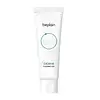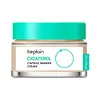What's inside
What's inside
 Key Ingredients
Key Ingredients

 Benefits
Benefits

 Concerns
Concerns

No concerns
 Ingredients Side-by-side
Ingredients Side-by-side

Water
Skin ConditioningPropanediol
Solvent1,2-Hexanediol
Skin ConditioningCentella Asiatica Extract
CleansingTromethamine
BufferingAcrylates/C10-30 Alkyl Acrylate Crosspolymer
Emulsion StabilisingGlycerin
HumectantCarbomer
Emulsion StabilisingHydroxyacetophenone
AntioxidantButylene Glycol
HumectantEthylhexylglycerin
Skin ConditioningDisodium EDTA
Hydrogenated Lecithin
EmulsifyingFicus Carica Fruit Extract
HumectantUlmus Davidiana Root Extract
Skin ConditioningSecale Cereale Seed Extract
AbrasiveCeramide NP
Skin ConditioningTocopherol
AntioxidantWater, Propanediol, 1,2-Hexanediol, Centella Asiatica Extract, Tromethamine, Acrylates/C10-30 Alkyl Acrylate Crosspolymer, Glycerin, Carbomer, Hydroxyacetophenone, Butylene Glycol, Ethylhexylglycerin, Disodium EDTA, Hydrogenated Lecithin, Ficus Carica Fruit Extract, Ulmus Davidiana Root Extract, Secale Cereale Seed Extract, Ceramide NP, Tocopherol
Water
Skin ConditioningGlycerin
HumectantButylene Glycol
HumectantMethylpropanediol
SolventCaprylic/Capric Triglyceride
MaskingHydrogenated Poly(C6-14 Olefin)
EmollientVinyldimethicone
Dicaprylyl Carbonate
EmollientPropanediol
SolventGlyceryl Stearate Citrate
EmollientNiacinamide
SmoothingIsononyl Isononanoate
EmollientGlycereth-26
HumectantDiisostearyl Malate
EmollientCetearyl Alcohol
Emollient1,2-Hexanediol
Skin ConditioningCentella Asiatica Extract
CleansingButyrospermum Parkii Butter
Skin ConditioningStearic Acid
CleansingHydroxypropyl Bispalmitamide Mea
EmollientMannitol
HumectantGlyceryl Stearate
EmollientDimethiconol
EmollientCetearyl Olivate
Sorbitan Olivate
EmulsifyingSodium Stearoyl Glutamate
CleansingAcrylates/C10-30 Alkyl Acrylate Crosspolymer
Emulsion StabilisingMacadamia Ternifolia Seed Oil
EmollientTromethamine
BufferingGlucose
HumectantEthylhexylglycerin
Skin ConditioningAcrylates/Ammonium Methacrylate Copolymer
Theobroma Cacao Seed Extract
AntioxidantDextrin
AbsorbentCeramide NP
Skin ConditioningAdenosine
Skin ConditioningDisodium EDTA
Cholesterol
EmollientPhytosphingosine
Skin ConditioningSilica
AbrasiveHydrogenated Lecithin
EmulsifyingBeta-Sitosterol
Emulsion StabilisingPanthenol
Skin ConditioningDipotassium Glycyrrhizate
HumectantAllantoin
Skin ConditioningPhytosterols
Skin ConditioningPentylene Glycol
Skin ConditioningCentella Asiatica Leaf Extract
Skin ConditioningSodium Hyaluronate
HumectantMadecassoside
AntioxidantCynanchum Atratum Extract
Skin ConditioningMadecassic Acid
Skin ConditioningAsiaticoside
AntioxidantAsiatic Acid
Skin ConditioningCitric Acid
BufferingWater, Glycerin, Butylene Glycol, Methylpropanediol, Caprylic/Capric Triglyceride, Hydrogenated Poly(C6-14 Olefin), Vinyldimethicone, Dicaprylyl Carbonate, Propanediol, Glyceryl Stearate Citrate, Niacinamide, Isononyl Isononanoate, Glycereth-26, Diisostearyl Malate, Cetearyl Alcohol, 1,2-Hexanediol, Centella Asiatica Extract, Butyrospermum Parkii Butter, Stearic Acid, Hydroxypropyl Bispalmitamide Mea, Mannitol, Glyceryl Stearate, Dimethiconol, Cetearyl Olivate, Sorbitan Olivate, Sodium Stearoyl Glutamate, Acrylates/C10-30 Alkyl Acrylate Crosspolymer, Macadamia Ternifolia Seed Oil, Tromethamine, Glucose, Ethylhexylglycerin, Acrylates/Ammonium Methacrylate Copolymer, Theobroma Cacao Seed Extract, Dextrin, Ceramide NP, Adenosine, Disodium EDTA, Cholesterol, Phytosphingosine, Silica, Hydrogenated Lecithin, Beta-Sitosterol, Panthenol, Dipotassium Glycyrrhizate, Allantoin, Phytosterols, Pentylene Glycol, Centella Asiatica Leaf Extract, Sodium Hyaluronate, Madecassoside, Cynanchum Atratum Extract, Madecassic Acid, Asiaticoside, Asiatic Acid, Citric Acid
 Reviews
Reviews

Ingredients Explained
These ingredients are found in both products.
Ingredients higher up in an ingredient list are typically present in a larger amount.
1,2-Hexanediol is a synthetic liquid and another multi-functional powerhouse.
It is a:
- Humectant, drawing moisture into the skin
- Emollient, helping to soften skin
- Solvent, dispersing and stabilizing formulas
- Preservative booster, enhancing the antimicrobial activity of other preservatives
Acrylates/C10-30 Alkyl Acrylate Crosspolymer is a synthetic polymer. It is used to thicken and improve the texture of products. Due to its properties, it can prevent water and oil ingredients from separating.
Butylene Glycol (or BG) is used within cosmetic products for a few different reasons:
Overall, Butylene Glycol is a safe and well-rounded ingredient that works well with other ingredients.
Though this ingredient works well with most skin types, some people with sensitive skin may experience a reaction such as allergic rashes, closed comedones, or itchiness.
Learn more about Butylene GlycolCentella Asiatica Extract (Centella) is derived from an herb native to Southeast Asia. It is famous for its anti-inflammatory and soothing properties.
Centella is rich in antioxidants and amino acids, such as Madecassic Acid and Asiaticoside.
Studies show the compounds in centella help with:
The combination of all these properties makes centella effective at soothing, hydrating, and protecting the skin.
Other great components of centella include Vitamin A, vitamin C, several B vitamins, and Asiatic Acid.
Fun fact: Centella has been used as a medicine and in food for many centuries. As a medicine, it is used to treat burns, scratches, and wounds.
Learn more about Centella Asiatica ExtractCeramide NP is a type of ceramide and formally known as ceramide 3.
Ceramides are intercellular lipids naturally found in our skin that bonds dead skin cells together to create a barrier. They are known for their ability to hold water and thus are a great ingredient for dry skin.
Ceramides are an important building block for our skin barrier. A stronger barrier helps the skin look more firm and hydrated. By bolstering the skin ceramides act as a barrier against irritating ingredients. This can help with inflammation as well.
If you would like to eat ceramides, sweet potatoes contain a small amount.
Read more about other common types of ceramides here:
Ceramide AP
Ceramide EOP
Disodium EDTA plays a role in making products more stable by aiding other preservatives.
It is a chelating agent, meaning it neutralizes metal ions that may be found in a product.
Disodium EDTA is a salt of edetic acid and is found to be safe in cosmetic ingredients.
Learn more about Disodium EDTAEthylhexylglycerin (we can't pronounce this either) is commonly used as a preservative and skin softener. It is derived from glyceryl.
You might see Ethylhexylglycerin often paired with other preservatives such as phenoxyethanol. Ethylhexylglycerin has been found to increase the effectiveness of these other preservatives.
Glycerin is already naturally found in your skin. It helps moisturize and protect your skin.
A study from 2016 found glycerin to be more effective as a humectant than AHAs and hyaluronic acid.
As a humectant, it helps the skin stay hydrated by pulling moisture to your skin. The low molecular weight of glycerin allows it to pull moisture into the deeper layers of your skin.
Hydrated skin improves your skin barrier; Your skin barrier helps protect against irritants and bacteria.
Glycerin has also been found to have antimicrobial and antiviral properties. Due to these properties, glycerin is often used in wound and burn treatments.
In cosmetics, glycerin is usually derived from plants such as soybean or palm. However, it can also be sourced from animals, such as tallow or animal fat.
This ingredient is organic, colorless, odorless, and non-toxic.
Glycerin is the name for this ingredient in American English. British English uses Glycerol/Glycerine.
Learn more about GlycerinHydrogenated Lecithin is created from the hydrogenation of lecithin (a group of phospholipids). Hydrogenation is a chemical reaction between hydrogen and another element.
This ingredient is an emollient and emulsifier. As an emollient, it helps soften skin by trapping moisture within. As an emulsifier, it prevents oil and water ingredients from separating.
Propanediol is an all-star ingredient. It softens, hydrates, and smooths the skin.
It’s often used to:
Propanediol is not likely to cause sensitivity and considered safe to use. It is derived from corn or petroleum with a clear color and no scent.
Learn more about PropanediolTromethamine helps balance the pH and improve the texture of a product. It is synthetically created.
As an emulsifier, Tromethamine prevents oil and water ingredients from separating. This helps stabilize the product and elongate a product's shelf life. Tromethamine also makes a product thicker.
Tromethamine helps balance the pH level of a product. Normal pH level of skin is slightly acidic (~4.75-5.5). The acidity of our skin is maintained by our glands and skin biome. Being slightly acidic allows our skin to create an "acid mantle". This acid mantle is a thin barrier that protects our skin from bacteria and contaminants.
Oral Tromethanmine is an anti-inflammatory drug but plays the role of masking, adding fragrance, and/or balancing pH in skincare.
1,3-Propanediol, 2-amino-2-(hydroxymethyl)-
Learn more about TromethamineWater. It's the most common cosmetic ingredient of all. You'll usually see it at the top of ingredient lists, meaning that it makes up the largest part of the product.
So why is it so popular? Water most often acts as a solvent - this means that it helps dissolve other ingredients into the formulation.
You'll also recognize water as that liquid we all need to stay alive. If you see this, drink a glass of water. Stay hydrated!
Learn more about Water